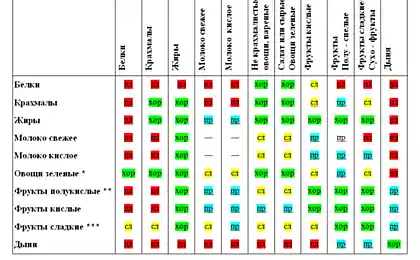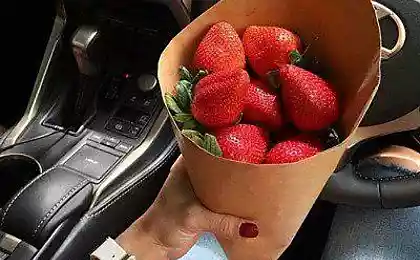768
Herbert Shelton: Correct and bad combination of food

Right and bad combination of food.To clearly understand which combinations of food are rejected by our enzymatic constraints, it is necessary to consider all possible combinations and briefly discuss them from the point of view of digestion, described in the previous Chapter. Such a study would be interesting and instructive for the thinking reader.
The combination of acids with starches, We found that even a weak acid destroys ptyalin of saliva. With the destruction of ptyalin starch digestion must cease. Physiologist Stejjlz says: "If mixed feeding begins with the acid, it is difficult to predict the hydrolysis (enzymatic digestion of starch) that is caused by saliva. However, at Breakfast we always eat acidic fruits before cereal and not notice the harmful effect. The starch that escaped digestion in this stage, forced to be subjected to the action of pancreatic juice, and the end result can be quite satisfactory. Still it is reasonable to assume that the more work done by the saliva, the easier the task, made for the other secretions and the greater the likelihood of complete digestion"
According to Howell, "this lens is quickly destroyed by the hydrochloric acid in acidity even at 0.2%, so if it has a functional role in gastric digestion, its action, like the ptyalin should be restricted to the early stages of digestion, i.e. before the contents of the stomach reaches its normal acidity."
Oxalic acid, diluted 1:10000, completely stops the action of ptyalin. 1-2 tea spoons vinegar contains enough acetic acid to completely stop digestion with saliva. The amount of acid contained in tomatoes, berries, oranges, grapefruits, lemons, pineapples, sour apples, sour grapes and other sour fruits (as well as sorrel, rhubarb, sorrel, sauerkraut, cranberries and needles of larch), it is enough to destroy the ptyalin of the saliva and stop the digestion of starch. Not knowing the cause, Dr. Howell writes: "Many people who cannot eat oranges at a meal derive great benefit if you eat them for 15-30 minutes before food."
All physiologists agree that acid, even weak, destroy ptyalin. Until then, until it is proven that saliva is able to perevarivaniu starch, no ptyalin, we have to continue to assert that the combination of the acid with starch is not digestible. Approval of people who never seriously studied human nutrition that any combination of products that you like, right — based on prejudice or blind bigotry. So our rule is: eat acids and starches at different times! (or acid — 15-30 minutes before meal!)
Combining proteins with starchesChittenden showed that free hydrochloric acid with a concentration of 0.003% sufficient to stop the action of ptyalin, breaks down starch (amiloliticescoe action), and further, even a slight increase in acidity destroys the enzyme. In his "Textbook of physiology," Howell writes about gastric lipase: "This lipase is rapidly degraded at the acidity of hydrochloric acid of 0.2%, so if it has a functional significance during digestion in the stomach, its action, like the ptyalin should be restricted to the early stages of digestion before the stomach contents reaches its normal acidity."
Here we do not refer to the destruction of lipase under the action of the hydrochloric acid of the stomach, speaking only about the destruction of ptyalin subjected to the same acid.
Physiologist Stejjlz writes: "Acid, which is highly favorable for gastric digestion, absolutely contraindicated in salivary digestion". Then he writes about pepsin: "the Ability to digest proteins is manifested only with an acid reaction and is gradually being lost, when the mixture becomes alkaline. Therefore, the conditions under which the digestion with pepsin, the same conditions which exclude the action of saliva. He writes about the salivary enzyme ptyalin: an Enzyme is extremely sensitive to acid. Since the gastric juice is undoubtedly acid, it can be argued that digestion with the help of the saliva cannot occur in the stomach." Gastric juice destroys the ptyalin and thus stops the digestion of starch. How are we supposed to digest starchy food? The secret is this: the stomach produces one kind of juice, when we eat starchy food and another kind of juice — when we eat protein foods.
Pavlov showed that every kind of food requires a specific activity of digestive glands and what strength juice varies depending on the quality of food; different types of food require specific changes in the activity of the glands; that the most highly active juice is highlighted when it is most needed.
When bread is eaten, the stomach stands out a little hydrochloric acid. The juice secreted on bread, has a nearly neutral reaction. When the starch is bread digested in the stomach is able to produce more hydrochloric acid to digest protein bread. The two processes — the digestion of starch and protein digestion is not happen at the same time. On the contrary, the secretion is very accurately regulated for the composition and the moment of selection to meet the diverse needs of the food substances of complex composition.
Here laid the answer to those who oppose the right combination of food on the basis that nature itself combines different foods in the same food. Between the digestion of a food, however complex its composition, and digestion of a mixture of different foods there is a big difference.
For one product, which is a combination of starch with protein, the body can easily adjust its juices (regarding power and time allocation) to the digestive requirements of this product. But when eaten two types of food with different, even opposite, digestive needs, this arrangement of juice becomes impossible. If bread and meat are eaten at the same time, it is almost neutral gastric juice, necessary for the digestion of bread, would immediately stand out highly acidic juice, and starch digestion sharply stop.
From a physiological point of view never lose sight of that first stage of digestion of starch and protein occur in the opposite environment. Starch requires an alkaline environment, and acidic protein. On this issue Professor of physiology, Mottram (London) in his work "Physiology" says that, when food in the stomach comes in contact with gastric juice, no complex digestion impossible. He says: "Now gastric juice digests protein and sluga digests starch. It is therefore evident that for efficient digestion of meat meal (protein) should be eaten first, and starchy foods are usually and tells instinct. Meat should precede the pudding, and this is the most economical process." Mottram, explains: "On the periphery of the stomach takes place vzbaltyvayut movement, mixing food with gastric juice. Food in a motionless part of the stomach is under the action of saliva, while in the mobile food part of the stomach comes in contact with the acidic gastric juice and salivary action is impossible." This simply means that if you eat protein first, then starch, then protein will be digested in the lower end of the stomach and the starch in the upper part.
If we assume that there is some dividing line between food in the stomach, then the right people do not consume protein along with starch. In England meat is eaten at the beginning of the meal, and pudding at the end. We in the country have similar practices, leaving the dessert on the end of the meal. When a person eats meat, eggs or cheese with bread, he eats bread with some protein. Sausages, ham sandwiches, toast with eggs and other similar combinations of protein with starch represent a common practice of such food. This diet protein and starch are thoroughly mixed in both parts of the stomach.
Howell makes a similar statement: "the Question of how difficult digestion under normal conditions, effect on starchy food, is of great practical importance. The process of chewing thoroughly mixes food in the mouth and saliva, or at least ought to do it, but most of the food to be swallowed very quickly, to give opportunity to the enzyme to complete its action. In the stomach the juice is sufficiently acidic to destroy the ptyalin of saliva, and therefore previously thought that salivary digestion is suspended in contact with food in the stomach and usually has little value as a digestive process. More recent studies of conditions in the stomach show that, on the contrary, some food may remain in some end of the stomach for one hour or more are not affected by the acidic secretion. Therefore, there is reason to believe that the salivary digestion to a significant degree may continue in the stomach".
It is becoming clear that salivary digestion may occur in the stomach to a significant extent only in a small amount of food eaten (assuming that food was a usual random mixture, for example, bread with meat, bread with eggs, bread with cheese, bread with other protein or potato protein). When someone eats a chopped schnitzel or sausage, then he does not eat first meat, then fried pastry. They eat together, chew, and swallow are mixed together. The stomach has no mechanism to separate these substances are thoroughly mixed and place them in different parts of its cavity.
Such mixing of food in nature will not see. Animals tend to eat one kind of food for the reception. Carnivores, of course, do not mix starches with proteins. Bird pecking insects at one time of day, and grain to another. Man, of course, it is better to follow this way of life.
Based on the physiological data presented above, we offer our second combination of food. It reads: eat proteins and carbohydrates at the same time!
This means that cereal, bread, potatoes and other starchy foods should be taken separately from meat, eggs, cheese, nuts and other protein foods.
The combination of protein with protein
Two proteins of different character and composition, in combination with other digestive factors require different modifications of the digestive secretions and different time of release of juice for its effective assimilation. For example, the most potent juice is secreted to the milk in the last hour of digestion, and the meat in the first hour. What is the significance of the time of secretion? In our practice of food we normally ignore such facts, and our physiologists do not attach any importance to such things. The eggs are the most potent secretion at the same time, as meat or milk — in more. It is therefore logical to assume that eggs should not be taken along with meat or milk. It's not too late to fix the damage to the tuberculosis patients that were fed a disgusting combination of eggs with milk. It is seen that for many centuries Orthodox Jews refrain from eating meat and milk at the same meal.
The fact that the digestive process needs to evolve to meet the requirements of each protein, but this is impossible when you eat two different protein at one meal. But this means that such protein combinations as meat and eggs, meat and nuts, flesh and cheese, eggs, and milk, eggs and nuts, cheese and nuts, milk and nuts should not be accepted. One protein food at one time should provide the most effective digestion.
Our rule of thumb: eat only one concentrated protein food at one time!
This rule was to put forward one objection, which reads as follows: the various proteins differ so much in their content of amino acids (and the body requires adequate levels of some of them) that it is necessary to consume more than one protein in order to ensure adequate supply of all indispensable amino acids. But due to the fact that the majority of people eats more than once a day, and protein is contained in almost every food we eat, this objection is unfounded.
The combination of the acid with the protein, Active protein digestion of complex substances into simpler substances occurs in the stomach and is the first stage of digestion of proteins when exposed to pepsin. Pepsin acts only in an acidic environment, alkali its action is terminated. The gastric juice changes its composition from nearly neutral to strongly acidic depending on the type of food that enters the stomach. When proteins are eaten, the gastric juice is acidic because it needs to provide a favorable environment for the action of pepsin.
Due to the fact that pepsin is only active in an acidic environment, many believe that taking acid with meals, to help digestion of protein. Medicinal and fruit acid, upsets gastric digestion by destroying the pepsin or slowing down its secretion. Gastric juice is not secreted in the presence of acid in the mouth and in the stomach. The famous Russian physiologist Pavlov demonstrated the adverse effect of such acids on digestion, as acid fruit, acid the end result, formentin. Sour fruits, retarding the secretion of gastric juice, free allocation which strongly requires the digestion of protein, seriously interfere with this and result in rotting.
The normal stomach secretes all the acid, which requires pepsin to digest all eaten the amount of protein. A sick stomach may produce too much acid (acidity) or insufficient amount of acid (lowered acidity). In any case, the consumption of acid with proteins helps the digestion. Although pepsin is not active in other conditions, except in the presence of hydrochloric acid (I have no evidence that other acids activate this enzyme), excessive gastric acidity prevents this action. Excess acid destroys pepsin. Based on these simple facts of physiology of digestion, our rule is: eat proteins and acids at the same time!
When we consider the actually occurring process of protein digestion in the stomach and, of course, check the effects of the acids on gastric secretion, we immediately recognize the fallacy of the consumption of pineapple, grapefruit or tomato juice with meat, which is recommended by several so-called nutritionists, as well as the fallacy of whipping eggs in orange juice to prepare the so-called "cocktail of vivacity", as suggest other pseudocatalase.
Lemon juice, vinegar or other acid, used in salads or added as a condiment, and eaten with protein foods, seriously inhibit the secretion of hydrochloric acid and thereby violates the digestion of proteins.
Although the nuts and cheese make a perfect combination with acidic fruits, however, we can make an exception to the above rule in the case of these two products. Nuts and cheese contain significant amounts of oil and fat, are the only exception to the rule that States that when acids are taken with protein, there comes decay. These products, if they are not immediately digested, do not decompose as quickly as other protein foods. In addition, acid do not delay the digestion of nuts and cheese as these foods contain enough fat to slow down gastric secretion for a longer time than do the acid.
The combination of proteins, fatsMac Leod in "Physiology in modern medicine" says: "it is Proved that the fats have a retarding influence on the secretion of gastric juice.., the presence of stomach oil delays the secretion of the juices secreted on subsequent food intake, in other terms easily digestible". In these words lies the important physiological truth, the full value of which is seldom realized. Most authors who write about food combinations, ignoring the overwhelming influence of fat on gastric secretion.
The presence of fat in the diet reduces cause appetite secretion, which is released in the stomach, reduces the amount of chemical secretion, decreases the activity of digestive glands, reduces the amount of pepsin and hydrochloric acid in gastric juice, can reduce almost twice the gastric tone. This slowing effect may last two or more hours.
In this regard, it should be noted that the foods that usually contain internal fat, such as nuts, cheese, milk, require a longer time to digest than protein products in which the fat is missing.
Our fourth rule is: eat fats and proteins at different times!
It is well known that plenty of green vegetables, raw special, counteracts the slowing effects of fats, therefore if you consume fat with protein, it is possible to eliminate its inhibitory effect on the protein digestion by eating with him a large number of green vegetables.
The combination of sugar with proteins
All sugar — trading sugar, syrups, sweet fruits, honey, etc. — exert an inhibitory effect on the secretion of gastric juice and the motility of the stomach. This fact gives importance to the comment made by the mother to the child that cake before eating "spoil the appetite". Sugar used with proteins, delaying the digestion of proteins.
Sugar does not undergo digestion in the mouth and in the stomach. They are absorbed in the intestine. If they are separate, they do not stay long in the stomach, and quickly pass into the intestine. But when they are eaten with other foods, proteins or starches, they are retained in the stomach for a long time, waiting until the digest other food. Thus, waiting for the complete digestion of protein and starch, they are fermented.
Based on these simple facts of digestion, our rule is: eat sugars and proteins at different times!
The combination of sugar with starch
Digestion of starch normally begins in the mouth and continues under appropriate conditions some time in the stomach. Sugar does not undergo digestion neither mouth nor stomach, but only in the small intestine. When sugars are consumed separately, they quickly go from the stomach to the intestines. When sugar is consumed with other foods, they for some time retained in the stomach, waiting for the other to digest food. As they tend to ferment very quickly in conditions of heat and moisture existing in the stomach, this type of food almost guarantees acid fermentation — fermentation.
Jellies, jams, fruit jams, sugar (white or cane, fruit or milk), honey, molasses, syrups, etc., added to cakes, bread, biscuits, cereals, potatoes, cause fermentation. The regularity with which millions of people eat a Breakfast cereal with sugar, suffer from increased gastric acidity, sour belching and other digestive issues. Sweet fruits with starch also lead to fermentation. Bread containing dates, raisins, figs, etc., so popular among the frequenters of the shops of "healthy food", is a dietary stuff. Many believe that if instead of sugar use honey, you can avoid fermentation, but this is not the case. Honey with hot cakes, syrup, hot cakes almost ensure fermentation.
But there are reasons to believe that the presence of sugar in the starch disrupt digestion of starch. When the sugar is placed in the mouth, there is a plentiful flow of saliva, but it contains no ptyalin, because ptyalin does not act on sugar. If starch is combined with sugar, honey, syrup, jelly, jam, etc., then it will prevent the adaptation of the saliva to digest starch. And ptyalin will also stand out little or no, and starch digestion will stop.
Reginald Austin says: "foods that are healthy in themselves or in certain combinations, it is often harmful, when eaten with other foods. For example, bread and butter, eat together, do not cause trouble, but if you add sugar or jam, or marmalade, may be followed by disease, because the sugar will be absorbed first, and the conversion of starch into sugar will be delayed. Starch and sugar cause fermentation and the accompanying harm."
On these facts we base the rule: eat starches and sugars at different times.
Fats
- Olive oil
- Soybean oil
- Sunflower oil
- Sesame oil
- Corn oil
- Cottonseed oil
- Peanut butter
- Avocado
- Most nuts
- Oranges
- Pineapple
- Tomatoes
- Sour apples
- Sour peaches
- Grapefruit
- Garnet
- Lemons
- Sour grapes
- Sour plum
- Oxalis
- Cranberry
- Fresh figs
- Sweet cherry
- Sweet Apple
- Sweet plum
- Mango
- Pear
- Sweet peach
- Apricots
- Blueberries
- Bananas
- Dates
- Figs
- Raisins nutmeg
- Prunes
- Dried pear
- Persimmon
- Starches
- All cereals
- Mature beans (except soy)
- Mature peas
- Potatoes (all kinds)
- Chestnuts
- Peanuts
- Zucchini
- Pumpkin
- Cauliflower
- Beets
- Carrots
- Rutabaga
- Salsify
- Eggplant
All the juicy vegetables, regardless of their color, for example:
- Lettuce
- Chicory
- Cauliflower (moderately starchy)
- Spinach
- Beet leaves (green)
- Mustard
- Turnips
- Mullein
- Broccoli
- Chard
- Cowslip marsh
- Green corn
- Cucumber
- Celery
- Cabbage
- Turnips, cress
- Cabbage feed
- Okra
- Chinese cabbage
- Eggplant
- Kohlrabi
- Parsley
- Watercress
- Bow-Pen, Shallot
- Garlic
- Bamboo shoots
- Asparagus
- Sweet pepper
- Green peas
- Watercress
- Asparagus
- Celery
- Cabbage
- Brussels sprouts
- Dandelion
- Turnip greens (green)
- Sorrel (sour)
- Rhubarb
- Bow
- Batavian (lettuce)
- Summer pumpkin
- Radishes
- Oxalis
- Cranberry
- Clover
- Nettle (stinging nettle and and)
- Sverbiga
- Winter cress
- Shepherd's purse
- Plantain
- Quinoa
- Horsetail
- Buds, flowers and leaves of Linden
- Birch leaves
- Needles of larch
- Lungwort
- Young shoots, flowers, buds and leaves of peas and other legumes
- Nuts (most)
- Seeds (etc., pumpkin, melon, watermelon, etc.)
- All cereals
- Mature beans
- Mature peas
- Soy beans
- Peanuts
- Olives
- Avocado published
P. S. And remember, just changing your mind — together we change the world! ©
Source: www.syroedenie.com/lib/shelton.html
You need to see this! How to make sausage production
Scientists blame sweets in the development of Alzheimer's disease























